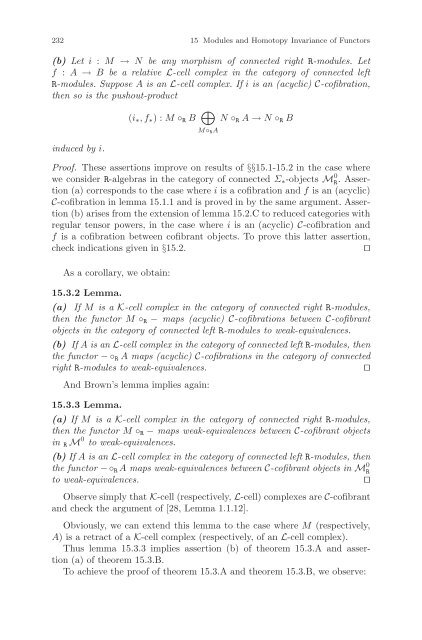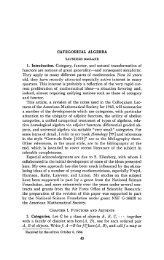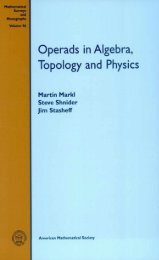Symmetric Monoidal Categories for Operads - Index of
Symmetric Monoidal Categories for Operads - Index of
Symmetric Monoidal Categories for Operads - Index of
Create successful ePaper yourself
Turn your PDF publications into a flip-book with our unique Google optimized e-Paper software.
232 15 Modules and Homotopy Invariance <strong>of</strong> Functors<br />
(b) Let i : M → N be any morphism <strong>of</strong> connected right R-modules. Let<br />
f : A → B be a relative L-cell complex in the category <strong>of</strong> connected left<br />
R-modules. Suppose A is an L-cell complex. If i is an (acyclic) C-c<strong>of</strong>ibration,<br />
then so is the pushout-product<br />
(i∗,f∗) :M ◦R B �<br />
N ◦R A → N ◦R B<br />
induced by i.<br />
M◦RA<br />
Pro<strong>of</strong>. These assertions improve on results <strong>of</strong> §§15.1-15.2 in the case where<br />
we consider R-algebras in the category <strong>of</strong> connected Σ∗-objects M 0 R. Assertion<br />
(a) corresponds to the case where i is a c<strong>of</strong>ibration and f is an (acyclic)<br />
C-c<strong>of</strong>ibration in lemma 15.1.1 and is proved in by the same argument. Assertion<br />
(b) arises from the extension <strong>of</strong> lemma 15.2.C to reduced categories with<br />
regular tensor powers, in the case where i is an (acyclic) C-c<strong>of</strong>ibration and<br />
f is a c<strong>of</strong>ibration between c<strong>of</strong>ibrant objects. To prove this latter assertion,<br />
check indications given in §15.2. ⊓⊔<br />
As a corollary, we obtain:<br />
15.3.2 Lemma.<br />
(a) If M is a K-cell complex in the category <strong>of</strong> connected right R-modules,<br />
then the functor M ◦R − maps (acyclic) C-c<strong>of</strong>ibrations between C-c<strong>of</strong>ibrant<br />
objects in the category <strong>of</strong> connected left R-modules to weak-equivalences.<br />
(b) If A is an L-cell complex in the category <strong>of</strong> connected left R-modules, then<br />
the functor −◦R A maps (acyclic) C-c<strong>of</strong>ibrations in the category <strong>of</strong> connected<br />
right R-modules to weak-equivalences. ⊓⊔<br />
And Brown’s lemma implies again:<br />
15.3.3 Lemma.<br />
(a) If M is a K-cell complex in the category <strong>of</strong> connected right R-modules,<br />
then the functor M ◦R − maps weak-equivalences between C-c<strong>of</strong>ibrant objects<br />
in R M 0 to weak-equivalences.<br />
(b) If A is an L-cell complex in the category <strong>of</strong> connected left R-modules, then<br />
the functor −◦RA maps weak-equivalences between C-c<strong>of</strong>ibrant objects in M 0 R<br />
to weak-equivalences. ⊓⊔<br />
Observe simply that K-cell (respectively, L-cell) complexes are C-c<strong>of</strong>ibrant<br />
and check the argument <strong>of</strong> [28, Lemma 1.1.12].<br />
Obviously, we can extend this lemma to the case where M (respectively,<br />
A) isaretract<strong>of</strong>aK-cell complex (respectively, <strong>of</strong> an L-cell complex).<br />
Thus lemma 15.3.3 implies assertion (b) <strong>of</strong> theorem 15.3.A and assertion<br />
(a) <strong>of</strong> theorem 15.3.B.<br />
To achieve the pro<strong>of</strong> <strong>of</strong> theorem 15.3.A and theorem 15.3.B, we observe:






